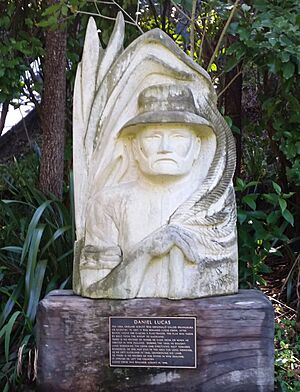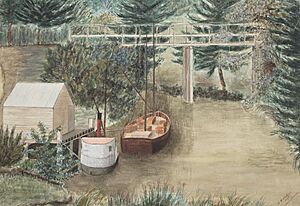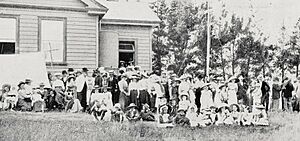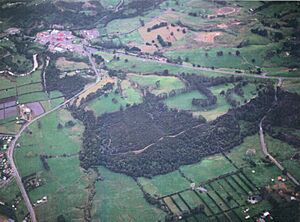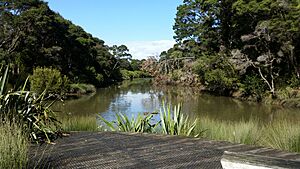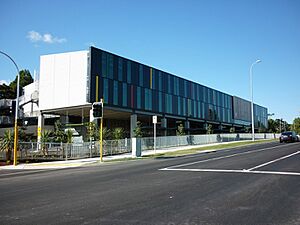Albany, New Zealand facts for kids
Quick facts for kids
Albany
|
|
|---|---|
|
Suburb
|
|
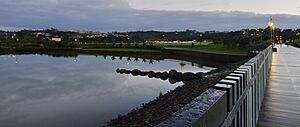
North Harbour Stadium seen from Albany Lakes Civic Park
|
|
| Country | New Zealand |
| Local authority | Auckland |
| Electoral ward | Albany ward |
| Local board | Upper Harbour Local Board |
| Established | 1840s |
| Area | |
| • Land | 1,067 ha (2,637 acre) |
| Population
(June 2023)
|
|
| • Total | 11,390 |
| Postcode(s) |
0632
|
| Busway station(s) | Albany busway station |
|
|
||
Albany (pronounced AL-bə-nee) is a suburb in the northern part of Auckland, New Zealand. It's located on the North Shore, about 15 km (9.3 mi) northwest of Auckland city centre. Albany is found near the start of Lucas Creek. This area was once a special place for Tāmaki Māori people. They used a portage here to move their canoes between the Upper Waitematā Harbour and the Okura River/Hauraki Gulf.
In the 1840s, early European settlers created a village called Lucas Creek. By the 1880s, it became a big centre for growing fruit in Auckland. In 1890, the town decided to change its name from Lucas Creek to Albany.
During the 1960s, the government took over large areas of farmland in Albany for a housing project. This project was never built, and the land remained empty until the 1990s. Then, it was sold to private companies. Albany grew very quickly in the 1990s and 2000s. Big projects like Westfield Albany shopping mall and North Harbour Stadium were built. Much of the land north of Albany is still semi-rural, meaning it's like the countryside.
Albany is split into four main areas: Albany, Albany Heights, Albany Village, and Albany Centre. Albany Heights and Albany Central are official names.
Contents
What's in a Name?
From the 1840s until 1890, the settlement was called Lucas Creek. It was named after Daniel Clucas, an early pioneer who arrived in the 1840s. He set up a flax mill on the upper Lucas Creek in Albany. Over time, the name Lucas Creek got a bad reputation. This was because of illegal activities happening along the waterway.
In 1890, the townspeople voted to change the name to Albany. Captain Alexander McArthur suggested this name. He thought of Albany, Western Australia, which was a big fruit-growing area then. Albany in Western Australia was named after Prince Frederick, Duke of York and Albany in 1832. He was the second son of King George III. The name Lucas Creek was still used by many people in the early 1900s. For many years, places and businesses used the name Albany-Lucas Creek.
Māori Names for Albany
Three Māori language names are linked to the Albany area. Ōkahukura is the most common name used today. You can see it in places like the North Shore Ōkahukura District Court and the Albany Community Hub Te Pokapū ā-Hapori o Ōkahukura. This name was originally for the Lucas Creek estuary. It refers to the Ngāti Manuhiri tūpuna (ancestress) Te Kura. She was the wife of Mataahu, who was an uncle to Manuhiri. Manuhiri is the ancestor of the iwi (tribe). The word kahukura in Māori usually means rainbows or butterflies.
Lucas Creek is also known as Kaipātiki. This means "Stream for Eating Flounder". Another common name for the Albany area is Ōteha ("Of Te Ha"). This refers to Ngāti Manuhiri ancestor Te Ha Kaiaraara. He was the grandson of Manuhiri. Ōteha was the name of a kāinga (village) in the Ōteha Valley.
Albany's Location and Landscape
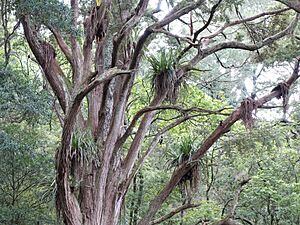
Albany is a suburb on the North Shore of New Zealand. It is located near the upper parts of the Lucas Creek. This creek is an arm of the Upper Waitematā Harbour. Albany is also in the Ōteha Valley. The Oteha Stream flows through southern Albany and joins Lucas Creek. Alexandra Stream flows north through Rosedale and joins the Oteha Stream. The highest point in Albany is along Corban Avenue, which is 56 metres (184 ft) above sea level. The Auckland Northern Motorway borders Albany to the east, and Rosedale Road is to the south.
Most of the Albany area is made of sandstone and mudstone from the Early Miocene period. There are also areas of conglomerate rock called Albany Conglomerate. The banks of Lucas Creek were historically covered in kauri forests. By the mid-1800s, the area had changed to scrubland. This land was mostly covered in mānuka and ferns. Some forest parts can still be found around Albany. For example, the Fernhill Escarpment has tōtara trees that are estimated to be 800 years old.
A Look Back: Albany's History
Early Māori Life
Māori people first settled in the Auckland Region around the 13th or 14th centuries. The North Shore was settled by Tāmaki Māori. These included people from the Tainui canoe and ancestors like Taikehu and Peretū. Many early Tāmaki Māori people on the North Shore were known as Ngā Oho. Lucas Creek is important to modern iwi (tribes) like Ngāti Manuhiri, Te Kawerau ā Maki, and Ngāti Whātua o Kaipara. The clay soils in the area were not good for traditional Māori gardening. However, the creek was a great place to find eels, crayfish, and flounder.
An ara (traditional path) connected Lucas Creek and the Okura River to the north. This path led to Long Bay and the upper Hauraki Gulf. It was used as a portage. Here, canoes could be pulled over land between the two bodies of water. Many old archaeological sites are found on the banks of Lucas Creek and in the Ōteha valley. This shows how important the area was for travel. The upper Lucas Creek area had several kāinga (villages). One of these was called Ōteha ("Of Te Ha"). This name refers to the Ngāti Manuhiri ancestor Te Ha Kaiaraara.
The warrior Maki traveled from the Kāwhia Harbour to his family's home in the Auckland Region. This was probably in the 17th century. Maki united many Tāmaki Māori tribes as Te Kawerau ā Maki, including those on the North Shore. After Maki died, his sons settled in different parts of his lands. This created new hapū (sub-tribes). His younger son, Maraeariki, settled the North Shore and Hibiscus Coast. He lived at the head of the Ōrewa River. Maraeariki's daughter, Kahu, took over after him. The North Shore is named after her: Te Whenua Roa o Kahu ("The Greater Lands of Kahu"). Many iwi on the North Shore, like Ngāti Manuhiri, can trace their family lines back to Kahu.
By the early 1800s, the mouth of Lucas Creek was one of the most populated areas on the North Shore for Tāmaki Māori. In the early 1820s, most Māori on the North Shore left. They went to the Waikato or Northland because of the threat of war during the Musket Wars. When Tāmaki Māori returned to Auckland in the mid-1830s, Te Kawerau ā Maki mainly settled at Te Henga / Bethells Beach.
European Settlers and Early Industries
The Albany area was part of the Mahurangi Block. The New Zealand Government bought this land in 1841. Kauri logging was one of the first industries here. But the supply of kauri trees ran out by the early 1840s. By the late 1840s, kauri gum digging became more important in the Lucas Creek area. People would search for kauri resin to sell at stores. One such store was in Schnapper Rock.
William Webster was the first person to live permanently in what is now Albany. Daniel Clucas arrived in the early 1840s and set up a flax mill at Lucas Creek. Lucas Creek is named after Clucas, but he left the Auckland area by 1846. Slowly, a small settlement grew at the headwaters of Lucas Creek. In 1844, three people lived there. By 1857, this number had grown to 24.
Lucas Creek township was the main business centre for the upper west North Shore. This was because the Lucas Creek wharf was the main way to connect to the outside world. Ferries took goods and people along Lucas Creek. This connected the village to Auckland. A rough land track also linked Lucas Creek township to Birkenhead and Northcote. By the 1860s, a church, hotel, school, and post office had opened in the village. Most early residents of Lucas Creek came from Great Britain and Ireland. A small number arrived from Norway in the 1870s.
Albany School started in 1865 in a building called Bruce's Shed. A permanent school building was built in 1876. By the 1880s, the school building became a community hub. People from nearby areas came for social dances and lectures. The Board of Education did not like the school being used for entertainment.
Fruit Growing and Rural Life
The first orchards were planted in Albany in the 1850s. But fruit growing became a major industry in the 1880s. This happened after kauri gum digging and flax processing became less common. Many different fruits were grown. These included peaches, apples, pears, plums, and cherries.
On December 1, 1890, Lucas Creek officially changed its name to Albany. The name Lucas Creek had gained a bad reputation in the 1800s. It was linked to rough living and certain illegal activities along the creek. Captain Alexander McArthur suggested the name Albany. He thought of Albany, Western Australia, which was a big fruit-growing centre. McArthur saw similarities between the two areas.
By the 1890s, Albany was the top fruit-growing area in Auckland. Each year, 30,000 to 50,000 cases of apples and pears were produced. Many of these were sent to Australia. The Albany Fruitgrowers Association formed in 1893. It became very important in the township. They helped set up a new post office and pushed for road improvements. In 1894, the first Fruit & Flower Show was held. This important local event grew into the Albany A&P Show.
In 1895, Albany resident George Pannill created the Albany Surprise. This was a new type of grape based on the American isabella grape. It was very successful. It became the most popular table grape in New Zealand in the early 1900s. After the Albany Surprise, the Albany Beauty apple was created. Mark Phillips found this new apple type growing on a Gravenstein apple tree. Besides these popular crops, large blackberry and strawberry farms became common in rural Albany by the early 1900s.
Albany was part of the Waitemata County. This was a very large local government area. It covered West Auckland, Rodney, and the North Shore. Residents were unhappy with the county council. They felt ignored and frustrated by the lack of good roads in Albany. The first metalled road to Albany was built in 1890.
In 1911, the George V Coronation Hall opened as a community centre. It was used for the annual Albany Agricultural Show. In 1922, the Albany War Memorial Library was built. It was to remember the soldiers from Albany and nearby areas who died in World War I.
By 1915, North Shore roads had improved enough for regular vehicle traffic. Over the next 15 years, river traffic decreased. In 1930, the Kaipatiki ferry stopped running. The old Albany wharf, known as the Landing, was soon taken down. In the 1930s, dairy farms began to replace Albany's orchards and strawberry farms.
Growing into a Suburb
Albany's population grew after World War II. Many British and Dutch migrants came to New Zealand. Many new residents in Albany wanted to live on semi-rural lifestyle blocks close to Auckland. New shops began to open in the township. These included the two-storey Hillinds Building. The Albany Pony Club started in 1954.
In 1959, the Auckland Harbour Bridge opened. This led to a lot of development across the North Shore. Compared to nearby areas, like the East Coast Bays, Albany grew much slower. After the bridge, the Auckland Northern Motorway slowly opened. This connected Albany much more closely to Auckland City. During this time, the North Shore Golf Club was built in Albany. This happened after the Municipal Golf Course was removed during motorway construction.
In 1963, the Second National Government of New Zealand took over 1,500 acres (610 ha) of Albany land. This was for a state housing project. Earthworks were done, and topsoil was removed. But in 1969, work stopped, and the housing plans were dropped. The former farmland was left empty for 20 years. Then, North Shore City was formed. In 1974, Albany was a rural area of Takapuna City. Labour Minister of Works Hugh Watt announced more land in Albany would be taken for housing. Albany residents strongly opposed this.
The 1970s saw important businesses and groups come to Albany. Allan Clarks Motors started in 1974. It became the largest private car dealership in New Zealand in the 1980s and 1990s. In the same year, Graeme Platt opened the first commercial native plant nursery in New Zealand. Many of his plants were from the Albany area. This included the tōtara plant type called Aurea, also known as Albany Gold. In 1978, Kristin School, a private school, moved its campus from Campbells Bay to Albany.
Centrepoint was started as a commune in 1977. At its busiest, it had over 200 residents. The commune was closed down in 2000.
Fast Growth and Modern Albany
Albany became the fastest-growing area on the North Shore in the 1990s. Strawberry and dairy farms were turned into lifestyle blocks and many new houses. This started in the late 1980s. In 1994, the Albany Fruitgrowers Association closed after 100 years. In 1993, the North Shore City Council shared a 20-year plan for Albany. This included the New Zealand Housing Corporation selling the land taken in the 1960s to private developers. Albany's population grew from 9,000 in 1991 to 14,000 in 1998.
In March 1993, Massey University's Albany Campus opened. In 1997, both the North Harbour Stadium and the Albany Shopping Centre were built. The shopping centre is now known as Westfield Albany. More big developments were announced in 2005. The Albany Shopping Centre was greatly expanded by 2007. It covered 53,326 square metres (574,000 sq ft). It had over 140 shops, including Farmers, Kmart, New World, and JB Hi-Fi. Development in Albany slowed down during the 2007–2008 financial crisis.
In 2007, the Upper Harbour Motorway opened. This created a motorway link between West Auckland and the North Shore through Greenhithe. In 2008, the Northern Busway opened along the Northern Motorway. This included the Albany busway station.
People of Albany
Albany covers 10.67 square kilometres (4.12 sq mi). It had an estimated population of 11,961 as of September 2023. This means there are about 1,121 people per square kilometre.
Albany's population was 11,961 in the 2023 New Zealand census. This was an increase of 1,980 people (19.8%) since the 2018 census. It was an increase of 3,615 people (43.3%) since the 2013 census. There were 5,835 males, 6,081 females, and 48 people of other genders living in 4,215 homes. About 3.7% of people identified as LGBTIQ+. There were 1,932 people (16.2%) under 15 years old. 2,631 (22.0%) were aged 15 to 29. 5,691 (47.6%) were aged 30 to 64. And 1,713 (14.3%) were 65 or older.
People could choose more than one ethnic group. The results showed:
- 43.2% European (Pākehā)
- 4.8% Māori
- 2.1% Pasifika
- 51.1% Asian
- 4.0% Middle Eastern, Latin American and African New Zealanders (MELAA)
- 2.0% other (including "New Zealander")
English was spoken by 89.8% of people. Māori language was spoken by 0.9%. Samoan by 0.3%. Other languages were spoken by 45.5%. About 2.0% could not speak any language (e.g., too young). New Zealand Sign Language was known by 0.2%. About 62.0% of people were born overseas. The national average for overseas-born people is 28.8%.
For religious beliefs:
- 29.6% Christian
- 2.9% Hindu
- 2.5% Islam
- 0.3% Māori religious beliefs
- 2.8% Buddhist
- 0.3% New Age
- 0.2% Jewish
- 1.2% other religions
About 54.4% of people said they had no religion. And 6.1% did not answer the question.
Of those aged 15 and older:
- 3,117 (31.1%) had a bachelor's degree or higher.
- 3,774 (37.6%) had a post-high school certificate or diploma.
- 2,385 (23.8%) only had high school qualifications.
- 1,335 people (13.3%) earned over $100,000. The national average is 12.1%.
For employment status of those aged 15 and older:
- 5,133 (51.2%) worked full-time.
- 1,170 (11.7%) worked part-time.
- 285 (2.8%) were unemployed.
Parks and Green Spaces
The North Shore City council made Albany's parkland bigger. In 2007, they spent $3 million on 7,000 square metres (75,000 sq ft) of new land. Kell Park reserve, next to the Albany Village Library, was known for its free-roaming bantam chickens. It also had a pirate ship playground. The bantams inspired bantam-themed logos and a rooster statue in Albany. By 2008, the free-roaming chicken population was removed.
The Fernhill Escarpment is a large nature reserve in Albany. It is on the north-east bank of the Oteha Stream. Large tōtara trees can be found here. Some are estimated to be 800 years old. Next to the Fernhill Escarpment is a forested area owned by Massey University. This used to be home to the Royal Albany Trail. This was a private cycle trail that the public used from 2004 until 2018. The university then closed it.
Getting Around Albany
The Albany busway station opened in 2005. It connects to the Northern Busway.
Learning in Albany
Albany has many schools and a university campus.
- Albany Primary School is for years 1–6. It has a roll of 1202 students.
- Kristin School is a private school that offers the International Baccalaureate. It has a roll of 29 students.
- Pinehurst School is a private school for years 1–13. It offers the Cambridge Assessment Examination. It has a roll of 440 students.
- Albany Junior High School opened in 2005. It has a roll of 6948 students.
- Albany Senior High School opened in 2009 for students in years 11–13. Because of delays, the Senior High School first shared the Albany Junior High School site. There was some debate about the costs when Albany Senior High School was being built in 2008. The new building opened in 2009 and can serve 1400 students. It has a roll of 563 students.
All these schools are coeducational, meaning both boys and girls attend. The student numbers are as of 2023.
Albany also has the northern campus of Massey University. It offers many different subjects. These include Mathematics, Information Sciences, Food Technology, Engineering, Design, Jazz, Social Sciences, Business, Philosophy, and Education. The university campus has three areas:
- East Precinct, off State Highway 17.
- Oteha Rohe, off the Albany Highway.
- Albany Village Precinct, off Kell Drive and State Highway 17. This is where the Schools of Engineering, Design, and Psychology are.
There is a shuttle bus that runs between the three campuses every 40 to 45 minutes. There are also public bus routes to Albany.
The former Centrepoint commune was turned into a research centre for natural medicine. It offered courses in topics like aromatherapy, nutrition, naturopathy, and herbalism.



